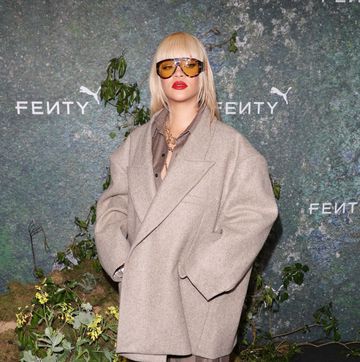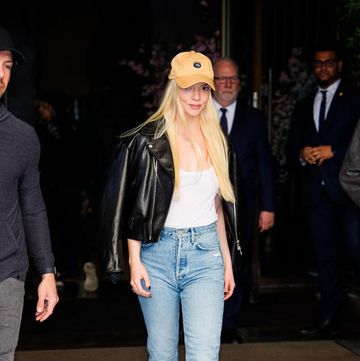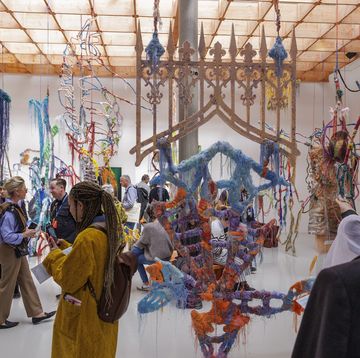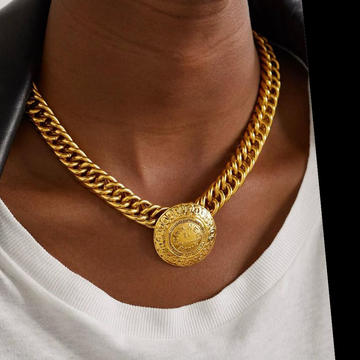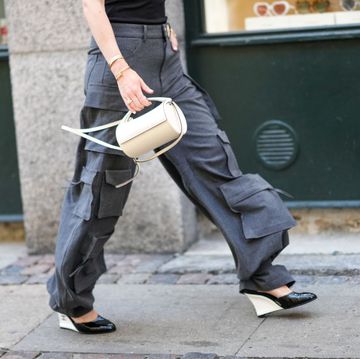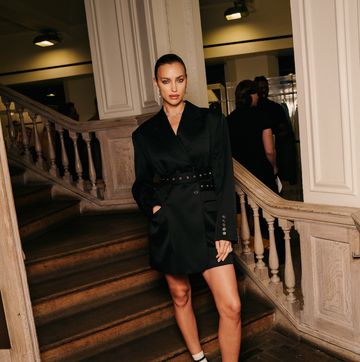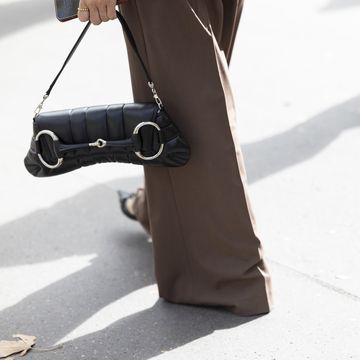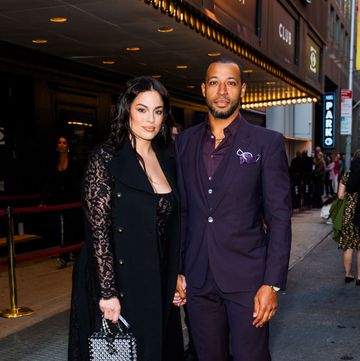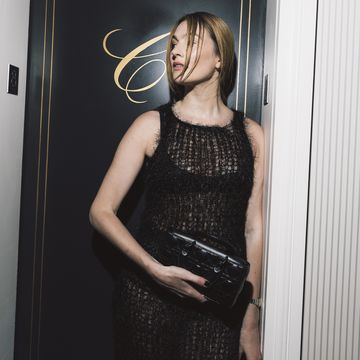Above: Jonathan Saunders s/s 2015, Getty Images
set his collection against the imposing architecture of the British Museum. But his collection was anything but imposing or architectural. He played the music to Jonathan Glazer’s creepy film Under The Skin, (filmed in Saunders’ hometown Glasgow), but his collection wasn’t dark or frightening. In fact, the music and the backdrop (perhaps intentionally?) highlighted the collection’s sweetness and innocence, while at the same time underscoring Saunders’ not-quite-what-she-seems woman. Needless to say that when Jonathan Saunders tackles femininity, there’s much more than sweet innocence rumbling beneath the surface. ‘It’s that confident femininity,’ he said after his show that opened in black – a slender coat and trousers – covered in fragile white bows and flowers. And when the bows got bigger, as they did when they wrapped trouser waists, they looked like the work of an origami expert. As for surface décor – no polite trims here – ruffles tumbled over a shoulder and across skirts, and fabric petals cascaded down a dress. You need only look at his unexpected colour palette – where any pretty blue was offset with vivid toffee, a stripe of caramel or shiny bronze – to see that Saunders doesn’t deal in banal ‘pretty’.
So what was the starting point? ‘A piece of paper,’ he said. ‘I found the most incredible paper fabric in a Japanese mill; the lightest thing you could ever imagine.’ This papery-fine fabric appeared in slim dresses, hand-printed with paper-shaped shadows in watery blues and greens. And that was at the heart of this excellent collection – lightness of touch. And Saunders’ still-subversive woman.
Where Saunders took a simple piece of paper, took the whole earth. Or rather the earth as it pulled apart 200 million years ago. If anyone can transfer the idea of tectonic plates shifting and the birth of the world’s flora and fauna on to 21st century clothes, it’s Mary Katrantzou.
On a black coal runway (those delicate Gianvito Rossi shoes!), her models stepped out in intricate puzzles of the most lavish fabrics imaginable. So, newly pulled-apart land became structured tops with ‘ruptures’ that revealed slices of skin beneath. Plants and serpents were the subject of specially commissioned woven lace or custom-made jacquards. Picture coral, seaweed and anemone embroideries on a series of shirt-dresses. Or floating seed-bead panels between the soft pleats of the most luxurious babydoll dresses. Or mythological beasts rearing up on lace shifts. Or the series of evening dresses with fractured bodices and hemlines erupting in horsehair embroideries.
You’ve got to hand it to Katrantzou, this was an absolute feat of engineering and needlework on the scale of the Paris couture. It’s even more incredible when you consider she only started out in business five years ago. But you’ve got to also wonder at the cost of such phenomenally intricate pieces – not just the unique fabrics, but the time required to make a single dress.
The world’s super-rich will, of course, be happy to pay for anything if it is utterly one-off – will these be? It’s admirable that Katrantzou has found a new way to tell her story – far, far away from the equally intricate but much more easy-to-copy digital prints on which she first made her name, but how relevant are dresses that can only be worn by the very few and how does this collection in any way address the needs of women with a mortgage to pay? Perhaps that was not the point here. At least, the high street won’t be copying her any time soon.
That moment when all the stars align for a designer? It happened at . For a moment there, it was as if we’d been transported back to New York: one simple bold idea, slickly executed and with all the ease, elegance and attitude of the best American sportswear. But this is a British designer with a passion for technology, so the collection opened in the dark with an illuminated fibre-optic slip dress (made together with leading tech company Studio XO) that initiated the collection’s ethereal quality.
‘It was about creating a modern lifestyle, with activewear and easy tailoring,’ said the designer backstage. ‘Slowing down, a moment of calm in our busy lives.’ So there were long, draped coats and jackets, fine slips sliced from fluttering layers, dip-dyed skirts that grazed the floor, jumpsuits that wrapped the torso – all in a dreamy, cloud-like palette, punctuated with the occasional crisp reflective skirt or sporty bomber jacket. Nicoll got the balance just right by offsetting the sensual tailoring with real activewear like running leggings and athletic bra-tops (produced in collaboration with Sweaty Betty) and great, slouchy open-weave knits: fantasy and realism beautifully combined.

